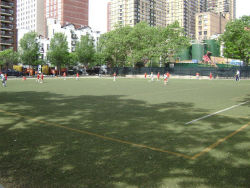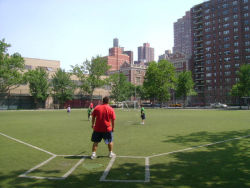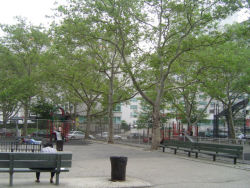Marx Brothers Playground
Playground Ninety Six (XCVI)
For fans of New York’s once-ubiquitous trolley cars, Playground Ninety Six sits upon a site of great historical interest. This park opened in the spring of 1947 on land formerly occupied by the car barn of the Second Avenue Railway, a fortress-like structure that once commanded the entire block. Horses stabled here in the 1870s and 80s, powered Second Avenue’s first public transportation line. In the 1890s, electric trolleys supplanted the horse-pulled cars. When buses replaced trolleys in the 1930s, the car barn was abandoned, sitting dormant until its demolition in 1941.
Playground Ninety Six was constructed to serve community residents and students at the adjacent vocational high school. Erected in 1941 as Machine and Metal Trades High School, the building has housed the School of Cooperative Technical Education since 1984. Today’s students choose from a broad array of occupational training, in fields including automotive repair, food preparation, horticulture, and welding.
When it opened, the school, with its clean, streamlined look asserted a fresh, modern aesthetic that reflected its technical curriculum. In 1942, famed architecture critic, historian, and professor Talbot Hamlin praised Eric Kebbon’s design as “…perhaps the most effective, even the most beautiful of New York City schools built within recent years. The long horizontals of its First Avenue front and the simple patterning of its masses, the attractive studied feeling of all its details are an almost perfect expression of the problem. It is slightly factory-like, yet not at all a factory; it is slightly school-like, yet by no means the ordinary secondary school.”
Across 96th Street sits the red brick building of former P.S. 150, designed by the illustrious school architect Charles B.J. Snyder (1860-1945) and completed in 1904. In 1927, the building became the home of Hunter Model School (today known as Hunter Elementary School), as well as the exclusive Hunter College High School, which was then open only to girls. After Hunter left in 1940 for its new Park Avenue location, the building was used by Machine and Metal Trades High School. Today, it is occupied by Life Sciences Secondary School, which prepares students for careers in medicine and related fields.
Although horsecars made inexpensive travel possible to this neighborhood, its development did not take off until the arrival of the Second Avenue El in 1880. By 1920, the surrounding blocks had almost completely filled with apartment buildings. Some of these early five-story tenements, such as those at 223-233 East 96th Street and 1817-1829 Second Avenue, remain; many, however, have been replaced by modern residential towers, including the George Washington Carver Houses, completed in 1957 between 97th and 104th Streets. Other tenements were demolished to make way for Metropolitan Hospital, erected in 1953 between 97th and 98th Streets.
The Second Avenue El was torn down in 1941, just a few months before this playground, located on Second Avenue between East 96th and East 97th Streets, was acquired. Among the features of the then-new facility, were a roller- and ice-skating area, softball diamond, sand pit, flagpole, wading pool, and the public restroom that remains today. In 2001, the playground, which is jointly operated by Parks and the Board of Education, was renewed with a $900,000 renovation funded by Department of Housing Preservation and Development that featured the installation of a synthetic turf surface, animal art, and new landscaping.
Check out your park's Vital Signs
Clean & Safe
Green & Resilient
Empowered & Engaged Users
Share your feedback or learn more about how this park is part of a
Vital Park System



